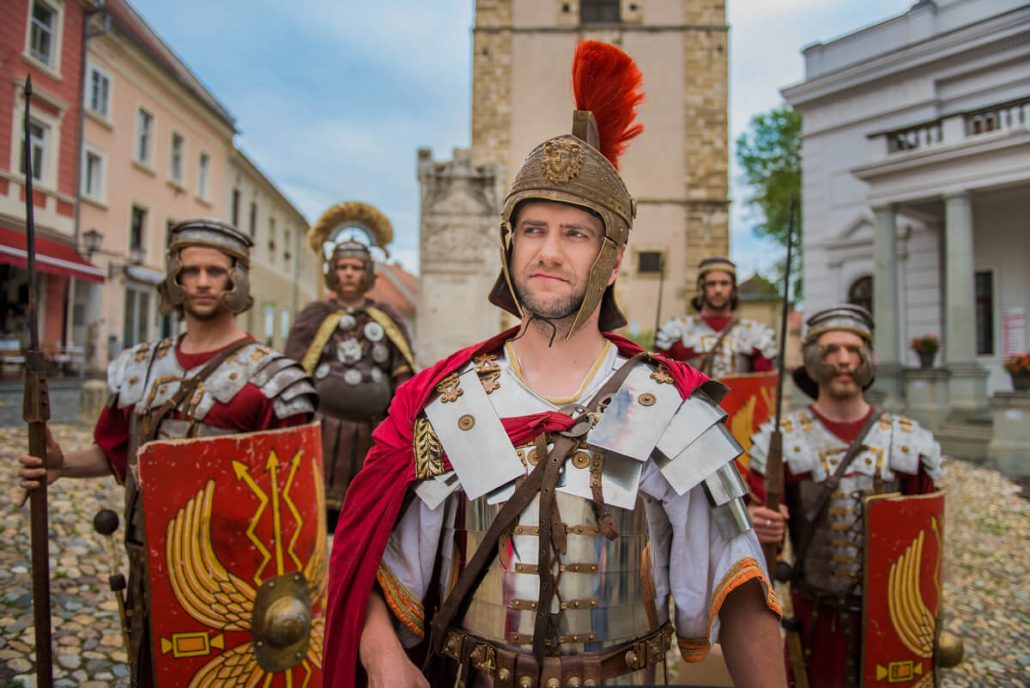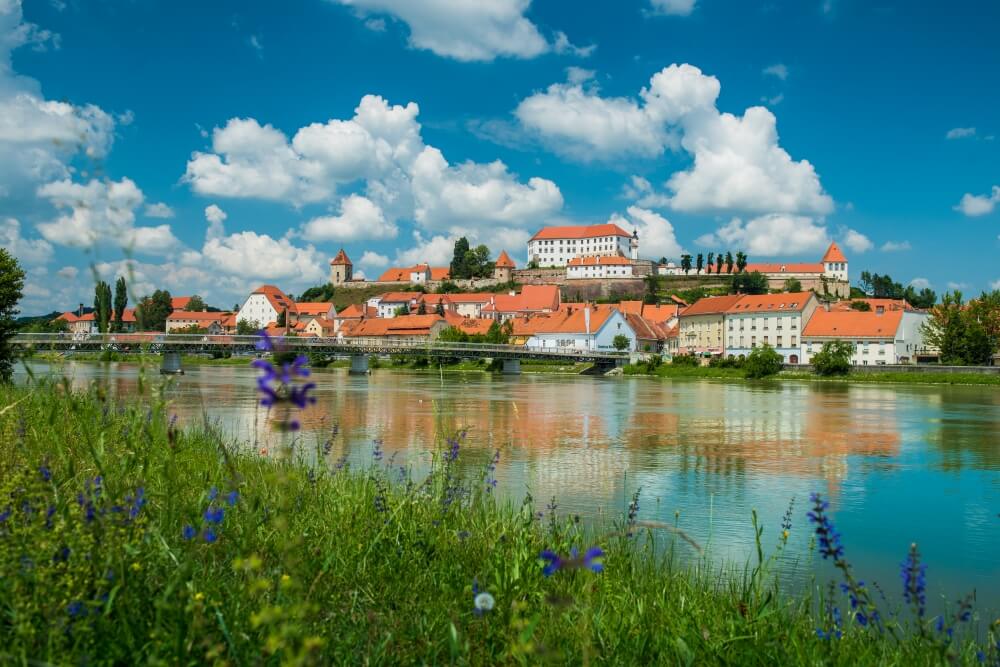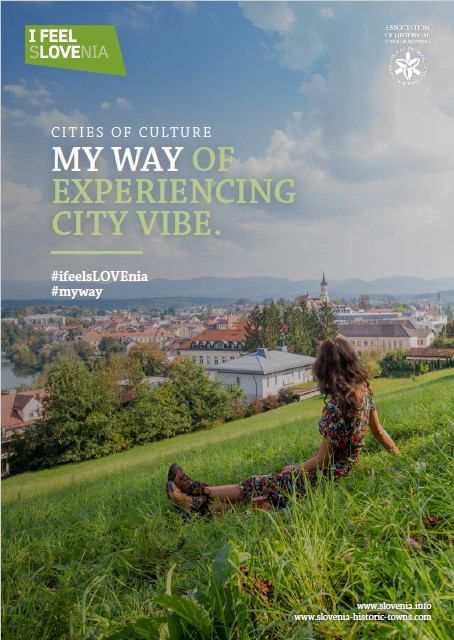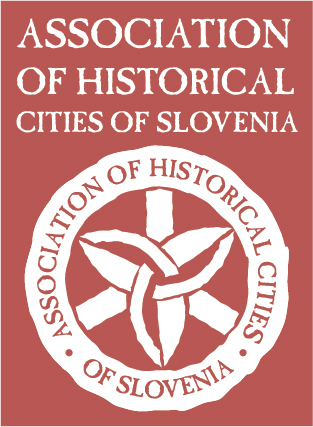Through the largest ancient city
Stroll through the old town core, venture up the slope of the Roman settlement and visit the castle hill. Get to know the unique character of this ancient metropolis!
From the river to Cesar Traianus
From the parking lot on Zadružni trg square by the Drava River, the most beautiful view of the old Ptuj opens before you! From here, enter the town of extraordinary stories across a pedestrian and cycling bridge. At Mestni trg square, visit the Ptuj Tourist Information Center (1), where you can also equip yourself with Guides to the Roman Stories of Ptuj. Look at the corner of the Town Hall (2). The statue of the Roman emperor Traianus greets you. He granted Ptuj city civil rights at the transition from the 1st to the 2nd century AD. The area of today’s Ptuj has since been called Colonia Ulpia Traiana Poetovio.
To the Orpheus monument
Go along Murkova ulica street and you will get to Slovenski trg square. The trademark of one of the town’s most beautiful squares is the mighty Orpheus monument (3), a Roman tombstone from the 2nd century with motifs of the mythical story of Orpheus and Eurydice. The three hollows on the monument are reminiscent of the Middle Ages, when the monument was used as a pillory. Just a few steps ahead is the mighty Town Tower (4), at the foot of which is the oldest Slovenian open-air museum. The Povoden Museum (5) includes a number of Roman monuments built into the walls of the Town Tower.
A Tip: Slovenski trg square with a Roman monument, the town tower with an onion dome, a beautiful theatre building and St. George’s Church is a popular photographic motif. There are also wine shops and bars where you can treat yourself to a glass of Ptuj wine!
Along the former Roman road
From the square, continue along Prešernova ulica street. It is the oldest street in the town, leading along a former Roman road. Stop at the Mitra Hotel, which already with its name reminds of the ancient worship of the old Persian deity Mithras. Archaeological remains of the 5th Mithraeum (6) await you in the hotel lobby, and you can see a replica of the statue of Mithras, born from the rock in the hotel garden. In the nearby Cankarjeva ulica street you can find traces of another cult from the time of Petoviona. On the relief plaque is a depiction of wet nurses (7). The stroll along Prešernova ulica street brings you to the Ivan Potrč Library (8) with a small exhibition area of remains from the Roman period, and to the collections of stone Roman monuments in the Stari zapori museum exhibition (9) beneath Ptuj Castle.
A Tip: In the Mitra family hotel, treat yourself to a cup of aromatic coffee roasted in Ptuj in the atrium. You can also arrange a tasting of fine wines in the basement of the hotel, which operates in one of the most beautiful bourgeois buildings in the old town.
Panorama park and the castle
At the edge of the town centre is a hill, which hides archaeological treasures of the mighty Petoviona. The secrets of the Panorama Archaeological Park (10) are revealed in descriptions along the walking paths, from where there is a beautiful view of Ptuj Castle (11). See the collections of the Ptuj – Ormož Regional Museum (12) in one of the most famous castle buildings in Slovenia. Here, musical instruments and weapons, traditional carnival masks and magnificent tapestries are on display. Do not miss the Roman flute called tibia in the musical instrument collection.
Back to the river. To the spas.
From the castle courtyard, enjoy the view over the brick roofs and cobbled streets of the oldest Slovenian town, and then descend back to the town on the southern side of the castle hill. The steps take you back to Slovenski trg square, from where you can easily head to the starting point of your wanderings around Ptuj.
A Tip: If you wish, you may experience Ptuj by walking along the other bank of the Drava River. Pot v Toplice road brings you to Terme Ptuj wellness resort. Treat yourself to a luxurious Roman Primus cake with a liquid chocolate core.
Suggestions for a hike
To a Roman camp
Only 3 kilometres from the old town of Ptuj, the Roman Poetovio camp stretches over two hectares. This permanent Roman-themed camp presents the way of life two millennia ago in an interesting and instructive way. Here you can learn how they prepared food in antiquity and taste typical dishes and drinks from Roman times. Every year at the end of August, the camp and other town locations change into the venue of the traditional Roman Games – the largest display of Roman life and ancient history in Slovenia.
More information: TIC Ptuj

1. Ptuj Tourist Information Center
TIC in the very centre of the oldest Slovenian town offers tourist information, guided tours of the town, souvenirs and publications about Ptuj, its surroundings and Slovenia. Here you can also choose between monographs and unique products. A special experience here is the entrance to Kurent’s room with the presentation of the most famous mask of the Ptuj Carnival and the heritage of Kurent walks, inscribed on the UNESCO World Intangible Heritage List.
Mestni trg 4, T: 02 779 60 11
2. Town house Ptuj
The most impressive house on the popular Mestni trg square is the work of the Viennese architect Max Ferstl from the early 20th century. Every Saturday, there are weddings in the wedding hall and the locals like to watch them from the café in front of the town hall. There is also a statue of St. Florian, who protects the town from fires.
Mestni trg 1
3. Orpheus monument
The five-meter-high marble monument, made of a single piece of Pohorje marble, is the largest tombstone in the Roman province of Pannonia. It was erected in memory of Marcus Valerius Verus , the then mayor of Poetovia, in the second century. It is adorned with scenes from the ancient story of Orpheus and Eurydice. In the central relief, Orpheus plays the lyre in grief for the lost Eurydice. The monument was used as a pillory in the Middle Ages. Iron clamps were attached to the lower part to hold the criminals in place, damaging the original inscription. The three hollows on the monument are reminiscent of medieval shackles.
Slovenski trg
4. Town tower
The symbol of the town’s power and strength is already mentioned in the town statute from 1376. Originally, the five-floor tower was covered with a gable roof. After a fire in 1705, it was lowered by one storey, and given an onion dome. At that time, it already served as the bell tower of St. George’s Church, which lost its tower in one of the fires. The tower is built of brick, and the floors are divided by stones. There are clocks on the three sides of the tower, and no clock on the fourth side, which faces the castle. The story goes that the townspeople took revenge on the castle lords, who did not want to contribute their share for clocks.
Slovenski trg 14
5. Povoden museum
The oldest open-air lapidarium in Slovenia is named after the curate Simon Povoden, who had ancient monuments from Ptuj and the surrounding area built into the town tower in 1830. Among them are parts of civil and military tombstones, ash bins, sacrificial altars, dedication plates with reliefs, and square blocks. The museum also includes sacrificial altars placed in niches on the north side of St. George’s Church, and a five-meter-tall Orpheus marble monument.
Slovenski trg 14
6. V. Mithraeum, Hotel Mitra
During the Roman Empire, Ptuj was an important, mighty town and a military post. With soldiers from the eastern lands, Mithraism, a Persian religion with secret rituals attended only by men, prevailed here. As many as five exceptional shrines of the god Mithras were discovered in Ptuj. On locations of the I. and III. mithraeums, i.e. Roman shrines from the 2nd and 3rd centuries, you can still see their foundations, altars, reliefs and cult images. The artefacts of V. mithraeum, discovered in the town centre, are on display at the Mitra Hotel.
Prešernova ulica 6, T: 02 7877 455
7. Roman monuments
In the courtyards of burgher houses in Prešernova ulica street, several Roman monuments or their remains are built in. In 3 Cankarjeva ulica street there is a built-in relief of the cult of ideal wet nurses. They were patronesses of families and guardians of children’s health. Their worship was very common in the 2nd century.
Prešernova in Cankarjeva ulica
8. Ivan Potrč library
The library, which is located in a striking Renaissance – Baroque building, called Mali grad, holds a small exhibition in the basement, where pottery and other remains from the Roman period are on display.
Prešernova ulica 33-35
9. Stari zapori exhibition, Ptuj Ormož Regional Museum
Stone Roman monuments are also included in the exhibition in Stari zapori (Old Prisons) – one of the branches of the Ptuj – Ormož Regional Museum. Here, the historical collection of Ptuj and its surroundings in the 20th century is on display.
Muzejski trg 1, Pokrajinski muzej Ptuj Ormož, T: 02 787 92 30
10. Panorama archaeological park
The Panorama hill is intertwined with walking paths, along which archaeological finds and findings about the ancient settlement are presented. The slopes were built with large buildings in a rectangular street grid. Along the main road that ran across the pass between Panorama and Castle Hill stood a large building with several paved spaces. At the top of the Panorama was also a larger building complex – probably a spa.
11. Ptuj castle
The castle hill has been inhabited in the 5th millennium BC. The medieval fortress, built on the site of the previous buildings, has been reigning over the town since the 11th century. The castle complex consists of a former administrative building, a central castle building, a granary, a stable, castle towers, a castle estate with three buildings, a castle wall with three portals, an earthen embankment and a watchtower. The collection of the Ptuj – Ormož Provincial Museum is on display in the castle, which has been extended several times.
12. Ptuj - Ormož regional museum
Among the various museum collections at Ptuj Castle, visitors are most attracted by the collection of weapons and the richest collection of historical musical instruments in Slovenia. Among approximately 300 instruments from the collection, there is also a rarity of world importance – the Roman tibia or the double flute from the 2nd or 3rd century. The exhibition is complemented by a rich collection of note sheets and a presentation of the history of musical life in Ptuj. The exhibition, which presents the development of Ptuj Castle, also presents the time of the Roman Petoviona, when there was a fortress and a shrine here.
Na Gradu 1, T: 02 748 03 60
- 11. Ptuj Tourist Information Center
- 22. Town house Ptuj
- 33. Orpheus monument
- 44. Town tower
- 55. Povoden museum
- 66. V. Mithraeum, Hotel Mitra
- 77. Roman monuments
- 88. Ivan Potrč library
- 99. Stari zapori exhibition, Ptuj Ormož Regional Museum
- 1010. Panorama archaeological park
- 1111. Ptuj castle
- 1212. Ptuj - Ormož regional museum





